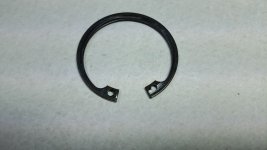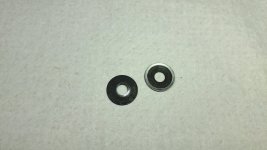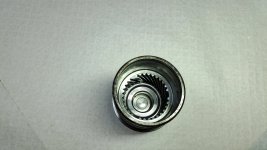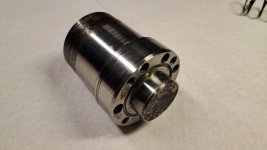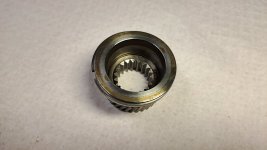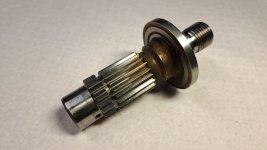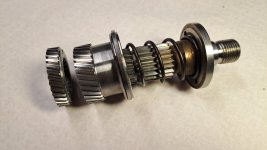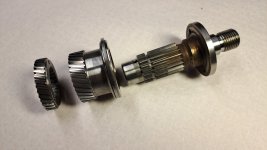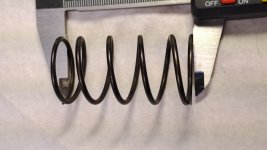The variator in my daughter's b -95 is acting up, and I have been trying to collect facts about the thing. I'm reaching out for help, and at the same time trying to share some of the info I have collected, to be commented and/or corrected:
The variator is becoming increasingly difficult to source new/unused and thus the prices are going up. However successful, this is an ambition to collect information about them, in one place, in an effort to increase the availability for the vehicles and owners in need, now and even more so in the future. I'm hoping that fact vs fancy can be sorted out over time collectively.
Much of the factual information about the variator(s) is, to me, shrouded in fog above the basic principle of it. Even basics like; who made them and/or are they still being made? I would expect that this information is available in the industry and I'm hoping it can be shared here.
The barchetta ePER lists two part numbers for variators originally equipped on the barchetta:
Companies selling variators (new, used and/or refurbished) claim that the variators with the part numbers below are interchangeable (new to old?):
717 383 60 (a)
608 156 44 barchetta 3/1999-6/2003 (a)
608 135 01 (until 7/2002) (a)
608 118 15 (until 5/1997) (a)
608 113 20 (until 3/1995) (a)
606 661 99 (a)
606 519 65 (up to 1/199(?)) (a)
606 179 17
606 038 04
552 027 72 barchetta 1995-3/1999 (a)
Anyone know the factual differences between all these part numbers? Is the latest the best?
(a) part number also listed with http://v4.barchetta-lexikon.de/index.php/lexikon/d/dieselteil
The same companies also claim that these variators can be found on/fit the following makes and models:
Alpha Romeo:
ALFA ROMEO 146 1.4 1.6 1.8 2.0 16V TS /
ALFA ROMEO 145 1.4 1.6 1.8 2.0 16V TS /
ALFA ROMEO 147 1.6 2.0 16V TS /
ALFA ROMEO GTV 1.8 2.0 16V TS /
Alpha Romeo Spider 1.8 2.0 16V /
Alpha Romeo 166 2.0 16V TS /
ALFA ROMEO GT 1.8 16V TS /
Alpha Romeo 155 1.6 1.8 2.0 /
Alpha Romeo 156 1.6 1.8 2.0
FIAT:
Fiat Barchetta 1.8 16 V /
(Brava HGT (South America)?)
Fiat Punto 188 1.8 16V / (same as Punto II HGT?)
FIAT COUPE 1.8 16V /
Fiat Stilo 1.8 16V
Lancia:
(Lancia Dedra 1.8 16v V.V.T. ?)
Lancia Lybra 1.8 16 V /
Lancia Delta ll 1.8 16V
Can anyone confirm the above? The make/model within parentheses, in Italic with question marks behind, have been added by me, it remains to be confirmed!
The Fiat Pratola Serra modular engines (also known as family B engines for the 4 cylinder units, and family C engines for the 5 cylinder units) are a family of engines produced by the Fiat Group since 1994 and used in Fiat, Alfa Romeo, Lancia and Jeep vehicles.
(They are developed to withstand turbocharging.)
Source: https://en.wikipedia.org/wiki/Fiat_Pratola_Serra_modular_engines
717 154 50 is a service kit containing a plastic/teflon/nylon washer and spring.
The variator is becoming increasingly difficult to source new/unused and thus the prices are going up. However successful, this is an ambition to collect information about them, in one place, in an effort to increase the availability for the vehicles and owners in need, now and even more so in the future. I'm hoping that fact vs fancy can be sorted out over time collectively.
Much of the factual information about the variator(s) is, to me, shrouded in fog above the basic principle of it. Even basics like; who made them and/or are they still being made? I would expect that this information is available in the industry and I'm hoping it can be shared here.
The barchetta ePER lists two part numbers for variators originally equipped on the barchetta:
- 1995 - march 1999 -> part number 552 027 72
- 1999 - 2003 -> part number 608 156 44
Companies selling variators (new, used and/or refurbished) claim that the variators with the part numbers below are interchangeable (new to old?):
717 383 60 (a)
608 156 44 barchetta 3/1999-6/2003 (a)
608 135 01 (until 7/2002) (a)
608 118 15 (until 5/1997) (a)
608 113 20 (until 3/1995) (a)
606 661 99 (a)
606 519 65 (up to 1/199(?)) (a)
606 179 17
606 038 04
552 027 72 barchetta 1995-3/1999 (a)
Anyone know the factual differences between all these part numbers? Is the latest the best?
(a) part number also listed with http://v4.barchetta-lexikon.de/index.php/lexikon/d/dieselteil
The same companies also claim that these variators can be found on/fit the following makes and models:
Alpha Romeo:
ALFA ROMEO 146 1.4 1.6 1.8 2.0 16V TS /
ALFA ROMEO 145 1.4 1.6 1.8 2.0 16V TS /
ALFA ROMEO 147 1.6 2.0 16V TS /
ALFA ROMEO GTV 1.8 2.0 16V TS /
Alpha Romeo Spider 1.8 2.0 16V /
Alpha Romeo 166 2.0 16V TS /
ALFA ROMEO GT 1.8 16V TS /
Alpha Romeo 155 1.6 1.8 2.0 /
Alpha Romeo 156 1.6 1.8 2.0
FIAT:
Fiat Barchetta 1.8 16 V /
(Brava HGT (South America)?)
Fiat Punto 188 1.8 16V / (same as Punto II HGT?)
FIAT COUPE 1.8 16V /
Fiat Stilo 1.8 16V
Lancia:
(Lancia Dedra 1.8 16v V.V.T. ?)
Lancia Lybra 1.8 16 V /
Lancia Delta ll 1.8 16V
Can anyone confirm the above? The make/model within parentheses, in Italic with question marks behind, have been added by me, it remains to be confirmed!
The Fiat Pratola Serra modular engines (also known as family B engines for the 4 cylinder units, and family C engines for the 5 cylinder units) are a family of engines produced by the Fiat Group since 1994 and used in Fiat, Alfa Romeo, Lancia and Jeep vehicles.
(They are developed to withstand turbocharging.)
Source: https://en.wikipedia.org/wiki/Fiat_Pratola_Serra_modular_engines
717 154 50 is a service kit containing a plastic/teflon/nylon washer and spring.
Last edited:






